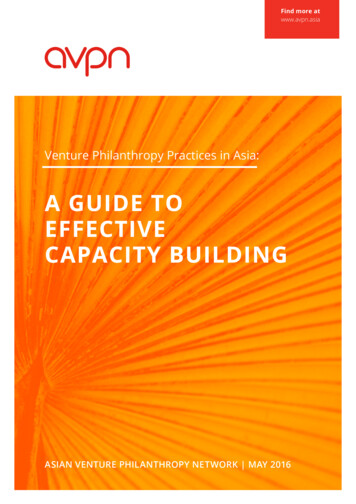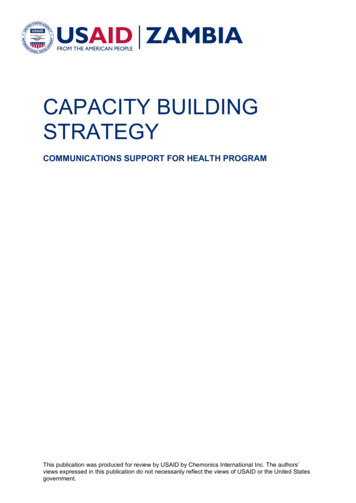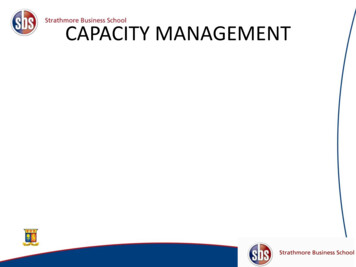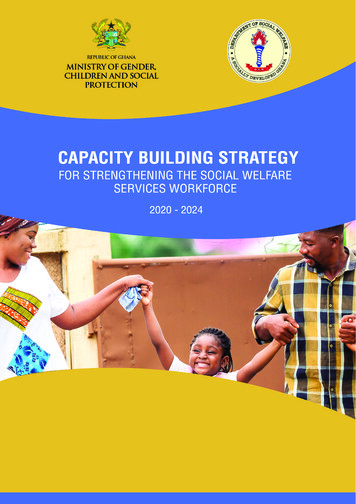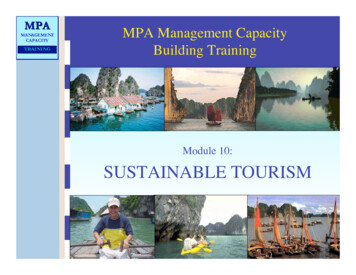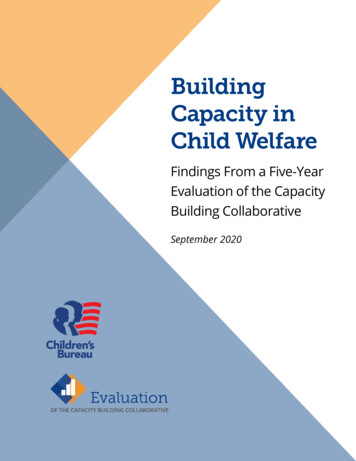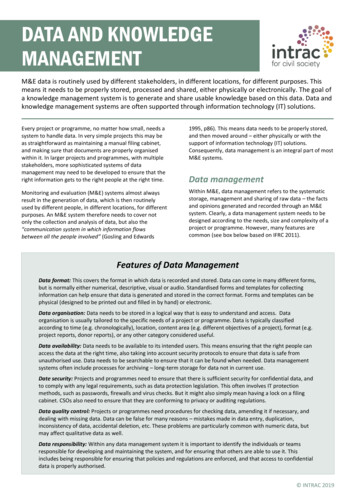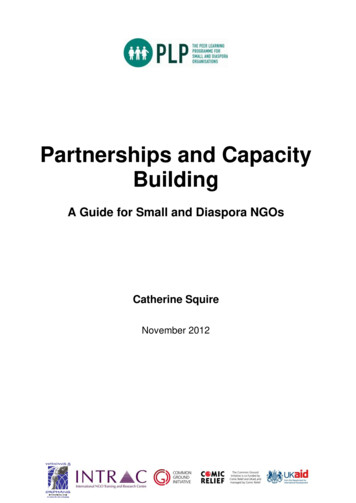
Transcription
Partnerships and CapacityBuildingA Guide for Small and Diaspora NGOsCatherine SquireNovember 20120
IntroductionPartnership and collaboration with other NGOs are no longer (if they ever were) aperipheral add-on to an organisation’s main work – for most organisations they are centralto the way in which they pursue their mission and objectives. A partnership that works wellcan produce results which inspire and surprise, while one that is struggling can drainenergy and resources from the organisations involved.This guide shares information, tools and tips that can help small and diasporaorganisations strengthen their partnerships and capacity building work. There is muchmaterial available. This guide highlights some key points, but we encourage you to delvedeeper by following the links and references provided.The toolkit starts by outlining the benefits of partnerships and the values which underpinpartnership work. It then examines different stages of a partnership and the tools,approaches and good practices that could help your partnership at each stage. The finalsection brings together some ‘top tips’ for successful partnerships and some thoughts oncapacity building with partners.1.What is partnership?At its simplest, a partnership is when two or more organisations work together towards acommon aim. In the NGO world, partnership is frequently “ understood as a code word toreflect humanitarian, moral, political, ideological or spiritual solidarity between nongovernment development organisations in the North and South that joined together topursue a common cause of social change.”1Within any definitions there are different types of partnership, each with different levels ofcommitment, resourcing, and power relations. It is, therefore, not surprising thatdifferences in expectations between partners can lead to misunderstandings and conflictin the partnership. However, not all relationships are partnerships and nor do they need tobe.Common challenges faced by small and diaspora organisations in managingtheir partnerships: Balancing values of solidarity with the need for accountability to donorsEnsuring acceptable and timely monitoring and reportingDifferent agendas and project vision of partnersBalancing unequal power relationshipsCreating opportunities to learn from partnersCommunicationProject management at a distanceTensions caused by partners juggling the needs of different donorsManaging changing systems/practices with established partnersDifferent working culturesTransparencyBuilding trustSustainability of projectsSource: PLP Partnerships Workshop September 2012 and participants’ registration forms1Fowler, A., 2000, "Partnership - Negotiating Relationships, Occasional Paper, No. 32, INTRAC, Oxford.Free download: http://www.intrac.org/resources.php?action resource&id 541
2.Why work in partnership?Partnerships are key to our capacity to promote change. Amongst other things, they canlead to:3. greater impact of our work: through partners we can mobilize more resources,influence different sectors of public opinion, increase our reach, and work with newnetworks and groups (our partners’ partners); stronger organisations: building and strengthening both ‘north’ and ‘south’ basedorganisations through solid relationships, trust and good communication; increased legitimacy: more use of local knowledge, projects appropriate to thecontext, including a diversity of voices, and a greater local ownership of work (notseen as a ‘northern’ initiative); greater effectiveness: partnerships provide opportunities to learn from each otherand improve the way we work; more negotiating power with donors, local government and powerfulstakeholders; greater participation of people living in poverty.A tool for thinking about partnershipsA mental model2 is useful to think clearly about what kind of partnership you are lookingfor with any particular organisation and to check that you see it the same way as yourpartner.Ask yourself thesequestions:How broad isthis partnership?How deepdoes it go?Where do wewant to be?And consider:How does ourpartner see it?2Based on Alan Fowler (previous page)2
It can also be useful to think about the types of partnership being developed and what thiscan means in terms of a partner’s power and engagement. The following table shows howit may look in theory:Type of partnership (Breadth) Power and engagement (Depth)Development allyShort relationshipInformation exchange, sharingexpertise, joint lobbying etcFunding not central to relationshipExample: networksInformation exchange Little commitment beyond regularlysharing knowledge and informationProject funderNarrow focus around specific projectsNegotiations and support arounddesign, funding, implementation andmonitoring of a project.Typically shorter (1-3 years)commitment Programme funderBroader engagement around a sectoror theme of developmentSupport can include funding, technicalexpertise, exchanges etc.Focus on outcomes of the work ratherthan on details of monitoring activities Institutional supporterSupport both for both what theorganisation does (effectiveness) andits viability as an organisationCan include development of policies,strategies, operations, management,and sustainability ConsultationViews are sought but no power toengage in making decisionsDominant partner takes all decisionsShared influencePartners are engaged in shaping theprogramme, providing ideas andopinionsThey will be involved in makingdecisions about activities and ways ofworkingJoint controlPartners have equal and full roles on aprogramme management committeeor similar function.Make decisions together at all levels:objectives, strategies and activities ofthe joint work.Partner Shared identityFull mutual support for all aspects of the work and wellbeing of each organisationFor example, most commonly found in religious denominations, professional groupingsThere are different (and increasing) rights and obligations involved with each of thesetypes of partnership. One way of addressing (if not redressing) power issues is to discussand negotiate the depth and breadth of your relationship with partners.The focus of partnerships is often on the work being done together, or the project beingcarried out. It can be difficult to create the opportunities to shift the focus onto therelationship and to take time to understand each other’s needs.3
An idea for how to use the model: discuss with your partner where you are now, andwhere do you both want to be. What would this involve in practice? How will you getthere? Some ways to help you move forward in this are explored in the sections in the restof this guide.4.Stages of Partnership – OverviewThinking of a partnership in different stages is another useful model to have in mindbecause at each stage there are different tasks and priorities needing attention. That’s notto say that all partnerships will follow this template, each will follow its own pathway. Thefollowing diagram highlights key stages in a partnership and some things to focus on ateach stage to build and maintain an effective partnership. Have a clear aim and purpose Understand your owncapacities as a partner Be clear what you are lookingfor in a partner. Make a plan for theend of thepartnership Communicate Celebrate thetransition or ending Build the relationship Develop a partneringagreementPreparingSustainingor ending Monitor and reviewthe relationshiptogether Managedifferences Build trustSetting upTending thepartnershipManagingthe work Monitor progress Review and learnfrom the worktogether RecogniseachievementsManaging thepartnership4
5.Stages of a PartnershipIn this section we will look at the four stages inthe life of a partnership.1. Preparing for partnership2. Setting up a partnership3. Managing a partnership4. Exiting or closing down a partnershipExamples of the added value of aPartnership Advocacy in the UK and globallyby the UK partner Long term objective/view Catalyst for change in bothpartner organisations Knowledge transferSource: PLP workshop flipchartThe names of tools that are in bold text in this section are described in detail at the end ofthis toolkit.5.1Preparing for partnershipLaying solid foundations for working in partnership means: Being clear about what is the added value you want from a partnership andwhy, and what you can offer to a partnership in terms of resources, skills, contacts,and people. The WWF Partnership Toolbox suggests using their OrganisationalContext Tool to help think these things through and prepare for other stages ofpartnership;Understanding your own capacities as a partner. It can be very illuminating toget feedback from your existing partners – what do they value about you as apartner? (You can also use a Capacity Assessment Tool like PQASSO; or a SWOTanalysis);Knowing what kind of partner you are looking for: a common source of frictionis not having shared values or organisational culture. Make a list of what isimportant to you in a partner and what you will look for (behaviour, attitudes tocommunities, competency, systems etc.);Looking widely for potential partners: a good partner is not necessarily among‘the usual suspects’. There could be community organisations, faith-based groups,or NGOs who have a low profile. Take time to ask different people and ask in thecommunity you want to support (e.g. at health clinics, primary schools, placespeople gather) – who do they feel is an effective organisation?Checklist of questions when identifying partners1. Are our mission and values compatible?2. What sort of organization is it – aims, activities, roles?3. What else does it do beyond the joint project we areconsidering?4. Do you know key facts about the background and links of theorganization and its leaders?5. Is there a degree of personal trust, based on knowledge of theorganisation’s track record, credibility and public image?6. Where does their funding come from and what conditions areattached?7. Will the cooperation contribute to our goals?5
5.2Setting up a partnershipAs one workshop participant commented: “The process of reaching an agreement/MOU isreally important”. Getting to know another organisation at a distance is challenging. Thereis often not enough time during visits to build up more than a formal knowledge of eachother. Several workshop participants emphasised that each situation is different and thereis no one solution to setting up a partnership. Having said that, here is a process whichothers have found useful in getting a partnership going:i.ii.iii.iv.v.vi.vii.viii.ix.x.5.3Visit your potential partner (both offices and project) and be open about yourpurpose. It is essential to be up front about your mission and values and to be clearabout what information you need from the prospective partners. Being open andencouraging questions from your potential partner will contribute to starting on ahealthy footing. Take note of their concerns and motivation.If practical, invite the director and senior staff to visit you.Meet informally with the director to review and feedback your thoughts so far.Agree next steps (if you both want to proceed).In agreement with the director, have an initial meeting with their trustees to explainyour ideas, set out a possible process for drawing up an MOU/agreement and givethem the opportunity to ask you questions.Share with your prospective partner the Partnership Agreement Tool in the WWFPartnership Toolbox3 (pages 10-15) or the MOU format you are using. Agree theheadings that are relevant to you and add any others as necessary. Give them timeto consider the different areas. Prepare your own responses.Agree a date for a meeting to discuss the agreement.Hold the workshop/meeting over one or two days. Allow time for meals andsocialising.Once the agreement is drafted, give time for relevant members of staff in bothorganisations to be consulted and for the agreement to be discussed line by line.MOUs are often skimmed over and poorly understood by the staff who have toactually do the work.Involve trustees/managers in final approval of the partnership as necessary.Celebrate your new partnership (more meals and socialising)!Managing a partnershipThere are two key elements of managing apartnership: 1) making sure you are achievingyour aims while, 2) also nurturing the relationshipbetween you. These need to be kept in balance.For example, a partnership that is achieving a lotwill tend to generate good feeling, confidence andtrust between partners. But if this goes too far andall the energy goes into work and meetingThe aims ofthe workTherelationship3The WWF Partnership Toolkit is free to download from:http://assets.wwf.org.uk/downloads/wwf parthershiptoolboxartweb.pdf. Pages 10-15 contain an excellentpartnership agreement tool which can be used to “help organisations prepare for and develop the keyelements of a negotiated partnership”.6
objectives, then communication and relationships may be neglected and frictions willappear. In the opposite situation where the relationship is going well but little is beingachieved, the motivation and morale of the partnership will eventually be affected.a) Monitoring progress of the joint workReports and field visits are the ground rock of your partnership, how you handle these canset the tone for your relationship. Here are some things that have worked for others:Do Take time to discuss a report (lots of time and effort went into it)Use this as an opportunity to build trust by showing you value what your partner isdoingMeet with your partner’s whole team to discuss a report, inviting reflection, analysisand learningFocus on what is going well and whyAsk open questionsDiscuss sensitive issues in an informal/off the record way, if possible in person in arelaxed settingBe pro-active in sharing relevant information (e.g. from donors or other agencies)Celebrate achievements!Don’t (!) Thank them for their report, then file and forget about itPhone out of the blue to analyse at length who is to blame for all the report’sshortcomingsSend the report back with red pencil all over itFly in and out on a 3 day visit with back to back meetings saying you’re in a rush togo somewhere else (giving the impression you have more important things to do)Cut off a suggestion of a meal together by saying you have to get to bed early toget through all the work tomorrow!b) Monitoring and nurturing the partner relationshipIt is easy to get caught up in our aim of making a differenceand focussing only on our joint work. Like a married couplewho plan a regular evening out without their children,nurturing a partnership needs time to be set aside andplanned in advance.Time for nurturing apartnership needs to beset aside and plannedin advance.Building trust is key to a relationship because only when partners trust each other will theybe able share what is really going on.An NGO worker in Nepal comments that:“It was extremely important to establish a sense of trust between myself and theBoard, which took many months and involved much tea-drinking, suppers in eachother’s homes and chatting about our families and life in general. Although this initiallychallenged my Western definition of ‘productivity’ I soon realised that this was timevery well spent In the long run, such ‘relationship building’ was a very important partof helping to ensure that the Board would receive my observations as constructive ”7
This story and other tools and approaches to understanding trust, power and relationshipsare in the brilliant Barefoot Guide to Working with Organisations and Social ChangeChapter 3.A more structured tool to talk about your relationship is in the Partnership Monitoring Toolon page 21 of the WWF Partnership Toolbox. This includes not just a checklist of what totalk about but a range of ideas for how to go about having the conversation. Both theWWF tool and Barefoot Guide are free to download.Make a space in the relationship to manage conflict as you go along – expect to discussdifferences in approach as they arise, make it part of the agenda to look at regularly, donot leave differences to grow unmanageable. One approach that helps to transformconflicts is described in Tool 2 (Backing up from ‘wants’ to ‘needs’) at the end of thisguide.Communication is the lubricant that keeps the engine of partnership running. PLPworkshop participants came up with a number of web-based tools to help communicationat a distance. These are described in Tool 6 at the end of this guide.c)Trouble hotspot: ReportsA recurring issue raised by a workshop participant (and many others):How real is the partnership? A significant issue, especially for reporting, ariseswhen despite having a good working relationship with the southern NGO, if at theend of the day the partner does not prepare reports in a timely manner, then theUK partner has to step in and ensure it is done (PLP Workshop participant)Many partnerships struggle with reporting. If this is true for you, and reports are late orpoor quality, try these strategies: Jointly prepare a work breakdown plan for the reporting process then draw up aGANTT chart (see Tool 1) so that realistic timings and who is responsible are clearand agreed. Plan a phone call two weeks before a report is due to discuss progress with collectingdata and to help analyse the information or clarify ideas. Share with your partner an example of what you consider a really good report, so theycan see what you are aiming for. Find an opportunity to talk to the person in an informal setting and try to understandthe blockages from their point of view – is the data late? Are they not used to writing?Are other commitments taking too much time? What help do they need from you?Then make a plan to address the underlying issues. Breakdown to a simple data format so that the information needed is clear. Increase reporting to monthly so that it is done in ‘bite sized’ pieces.8
5.4Exiting or closing down a partnershipIf you’ve made a partnership agreement, you’ll probably have included a section on howand when the partnership is expected to end. Even so, it may be a difficult time for bothorganisations and needs careful planning and, where possible, joint decision-making. Notall endings are painful; this is also the time for celebrating the achievements of thepartnership, and for looking forward to whatever will take its place.Exit strategies need to be discussed with partners to manage expectations and gain clarityon why, how and when partnerships will come to a close. A good exit strategy is based ontransparency about the priorities for each organisation from the beginning and strongmutual goals.Options include: Defined fixed term (e.g. 3 years, length of programme/project);Defined goal (e.g. when ‘x number of midwives have been trained’);Defined conditions (e.g. when the partner organisation is legally registered; whendonor funding is not renewed);Mutual agreement, at any time.Extra care is needed if the decision to end the partnership is one-sided and perhapsunexpected. Work together on a plan to manage the change and especially: Be honest and transparent about what is driving the end of the partnership;Give time for your partner to find a new funder;Communicate and consult with staff and other stakeholders;Help the organisation to find other sources of funding (working with a local consultantand/or using tools such as a Resource Mobilization Guide).6.Capacity Building6.1Capacity building with partnersThe starting point in any capacity building initiative is deciding what the capacity building isfor. For example, is it to enable the organisation to lay a secure foundation for the future orto ensure that it can produce the right kind of reports for the donor?Successful capacity building (CB) thinks about the needs of the organisation as a whole,and how the ‘bit’ of capacity that is being developed contributes to its overall effectiveness.Models of organisations help to picture this (see below).CB often starts with some kind of assessment of an organisation’s capacities, using a toolwith a system of scoring. There are a number of tools available, including for examplePQASSO and Bond’s ‘health check’ tool. These tools help to identify strengths as well asweaknesses, to prioritise areas for CB, and to track progress.As important as the tool used, is the process for using the tool. An assessment can makeyour partner feel vulnerable. If possible, plan and agree with your partner/s the process forthe assessment, its purpose (will funding depend on the result?), who will lead the processand how the results will be used and shared. Consider a mutual process where they get a9
chance to assess you as a partner for example, using the Keystone DevelopmentPartnership Survey.a) Using models of organisations to think about capacity buildingModels give us a way to visualise and talk about our organisation. When used withpartners, models can be helpful to create a shared language for thinking about whatcapacities are needed, and for what reasons.Model of an organisation as a person:Thinking of an organisation in this way highlights how all the parts of an organisation needto work together and work well in order to be effective. Use this as a group exercise withpartners to label different parts of the body according to how they see the parts fittingtogether, and the different contributions each part makes. You can also discuss whichfunctions of the ‘body’ are working best, which need strengthening, and which are not ‘wellconnected’ with the others.Seeing far away aswell as close up,looking to the futureSpeaking out,advocating,communicatingShoulders tocarry the loadMuscles for strength,and power to keepgoingResources (food) to fuelthe organisationLegs to take us wherewe need to goThinking: planningahead, organising,putting systems in placeListening: to partners,stakeholders, staff A heart to feel and putvalues in a centralplace; a pump to keepeverything goingHands to connect toothers; to do things;to carry out workJoints for flexibilityFeet to cover lots ofground, keep moving10
The three circles model:Another way of looking at an organisation is to think of the three main areas of capacitythat it needs in order to be effective: an effective internal structure (mission, values,systems, etc.); good programmes (making a difference for beneficiaries, skilled staff,resources); and, external links (with donors, stakeholders, media etc.). All of these need tobe appropriate for the context the organisation works in.ContextInternalOrganisation'To be'ExternalLinkages'To relate'ContextProgrammePerformance'To do'ContextCapacity building needs to consider all three kinds of capacity since they are inter-related.An organisation may focus exclusively on building capacity for programme planning orreport writing and forget the need to also build its own internal systems. A problem in onearea may actually be due to poor capacity in another ‘circle’. For example, poor projectmanagement might be because of a lack of capacity in involving beneficiaries (‘to relate’),and not because of a lack of project planning skills.Organisational assessment tools are often based around versions of the three circlesmodel.The Lifecycle Model (see Tool 5 below for more details):11
You can think of an organisation as moving through different stages of its life cycle: Ateach stage, different strategies for building capacity will be appropriate. For example, at‘adolescence’ organisations can be very innovative, but dependent on a founder-figure. Atthis stage an organisation will need to focus on the transition to a broader leadershipstructure in order to grow in effectiveness. On the other hand, when an organisation haspassed its prime, it may stick to old routines and inflexible approaches which make it lesseffective. Capacity building strategies at this stage would seek to help the organisationlook at new ways of doing things or strengthen its capacity for learning.Each of the three models illustrated above can be used to start discussions with partnersabout their (and your) respective strengths and weaknesses, and priorities for capacitybuilding.6.2Capacity building with community based organisations (CBOs)4Building the capacity of informal community groups throws up some different challenges tobuilding the capacity of more formally established organisations. By definition, CBOs haveinformal structures, are often not registered, usually run by a small volunteer committee,and have little funding. They are also strongly embedded in a community, often led byinformal community leaders, and operate in a fluid, informal way. The members of thegroup and volunteers can also be the beneficiaries of the organisation (examples arewomen’s groups, lobbying movements or sport associations).Strengths of CBOs often include: clarity on the organization’s vision and identity which provides a source of energy indifficult times;leadership which is strong and inspiring and yet democratic and enabling;strong personal relationships, within the CBO, with the community, and with otherstakeholders;good at mobilising resources in kind (services, gifts, volunteers etc.);effective networking.There is a risk in capacity building with CBOs that trained people may leave to get ‘proper’jobs. Sometimes, leaders may not distinguish between themselves and the organization –with a risk of unethical leadership.Questions to ask ourselves when working in CB with CBOs:1. Are we recognising CBOs’ strengths or making them feel undermined for not being‘up to standard’?2. Are we trying to help these groups develop and professionalise or are we workingto help them have greater impact?3. How can we make the process open-ended and flexible so that it is always relevantto the CBOs’ needs?4. How are we helping CBOs to develop the capacity for reflection and learning?5. By formalizing CBO structures are we actually contributing to increasing capacity?4Based on a ‘thinking paper’ for an INTRAC conference on Civil Society & Capacity Building:Organisation Development with CBOs (working in South African townships) by Schirin Yachkaschi,November 2006 (available on request, please email: info@intrac.org)12
7.Conclusion and Practical TipsPartnerships are not a soft option! With care and resources though, a partnership shouldenable you to transform the lives of people you could not otherwise reach. The tools in thisguide give you lots of ideas and practical things to do to find your way.Here are a few ‘top tips’ for successful partnerships: Make your plans achievable. Make your partners’ needs a priority: this has disproportionate influence on buildingtrust as it shows that you care about them through practical actions, rather than justwords and agreements. Share the same level of information about your own organisation as you ask ofthem. Let them make choices about what information they get, rather than actingas a ‘gatekeeper’ and only allowing through what you think they need. They mayneed more context, different contacts, other sources etc. Showing that you arebeing open and not trying to control their access to information will build trust. Plan outings, social events, meals, and celebrations to get to know people, as wellas more formal meetings to discuss the partnership. Celebrate partnershipbirthdays, anniversaries, achievements, and endings. Invite feedback on how you are doing as a partner. Recognise that there are manythings that you can learn from your partner. Identify together areas where they canbuild your capacity. Build relationships across a range of people in each organisation: trustees,managers and staff. This makes your partnership less vulnerable if a key personleaves.13
Tool 1: GANTT chartA tool for accurate planning of a sequence of tasksSteps:1.2.3.4.5.Draw up a list of all the separate steps or tasks that need to be done to achieve theobjective – this could be a whole project, or could be a small part such as amonitoring report.Put them in order of what needs to be done first before the next task can start.For each activity estimate how long it will take (in days or weeks).Draw up the chart showing the sequencing of tasks (e.g. when building a houseyou can’t start on the walls until after the foundations are finished)If possible, involve the main people who will be actually doing the work to checkthat all the activities, days and sequence are described as they see it. It may be atthis stage that you discover that there are blocks in the sequence you weren’taware of, which are holding up the activity.Example:When doing a GANTT chart for a reporting process you start with the writing of the firstdraft and end with the date the report needs to be submitted to the funder. In the middleare target dates for various people to review the report and opportunities for revision.When the GANTT chart is discussed with the staff member responsible, she points out aproblem; she is often unable to start work on a draft because field staff have not given herthe raw data on time, or some data is missing. As a result of this analysis, you can goback a step and work with field staff to address the issues of timely data collection.14
Tool 2: Backing up from ‘wants’ to ‘needs’A tool for transforming conflictWhen discussion of a problem seems to be going around in circles, it can be extremelyhelpful to shift discussion from what you want, to what you need.Example:Stating our positions on a decision sometimes makes it appear that there is a conflict e.g.a decision on where to hold team meetings:Finance Person: I want our team meeting to be held in our field office every month.Team Leader: Team meetings should be in head office.The two positions seem irreconcilable. Whichever decision is taken one side will win andthe other will lose. But if we ask about the needs we may get a different pictur
Project management at a distance Tensions caused by partners juggling the needs of different donors Managing changing systems/practices with established partners Different working cultures Transparency Building trust Sustainability of projects Source: PLP Partnerships Workshop September 2012 and participants' registration forms
